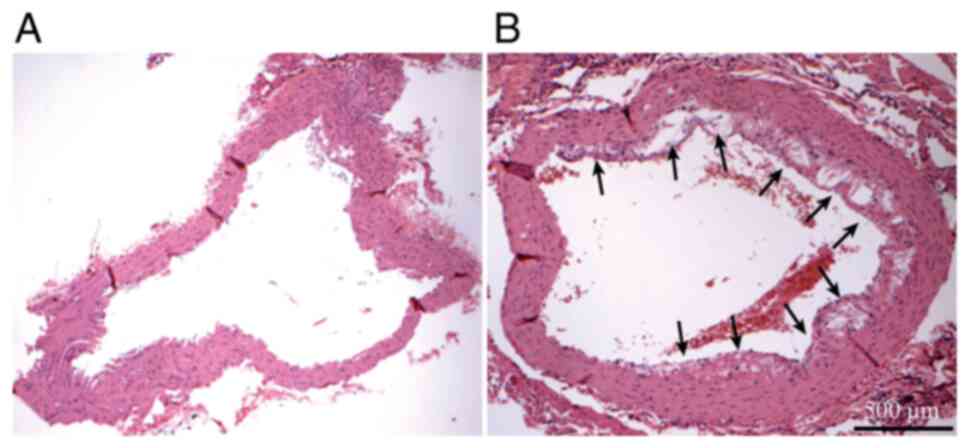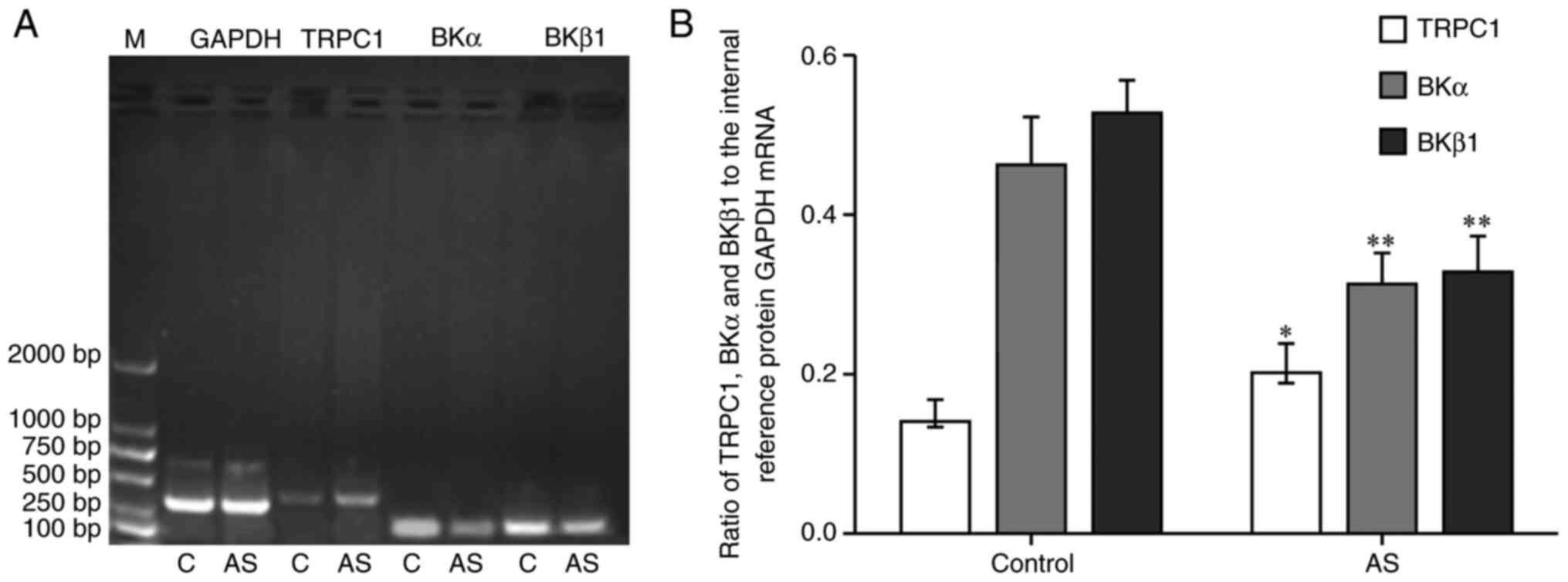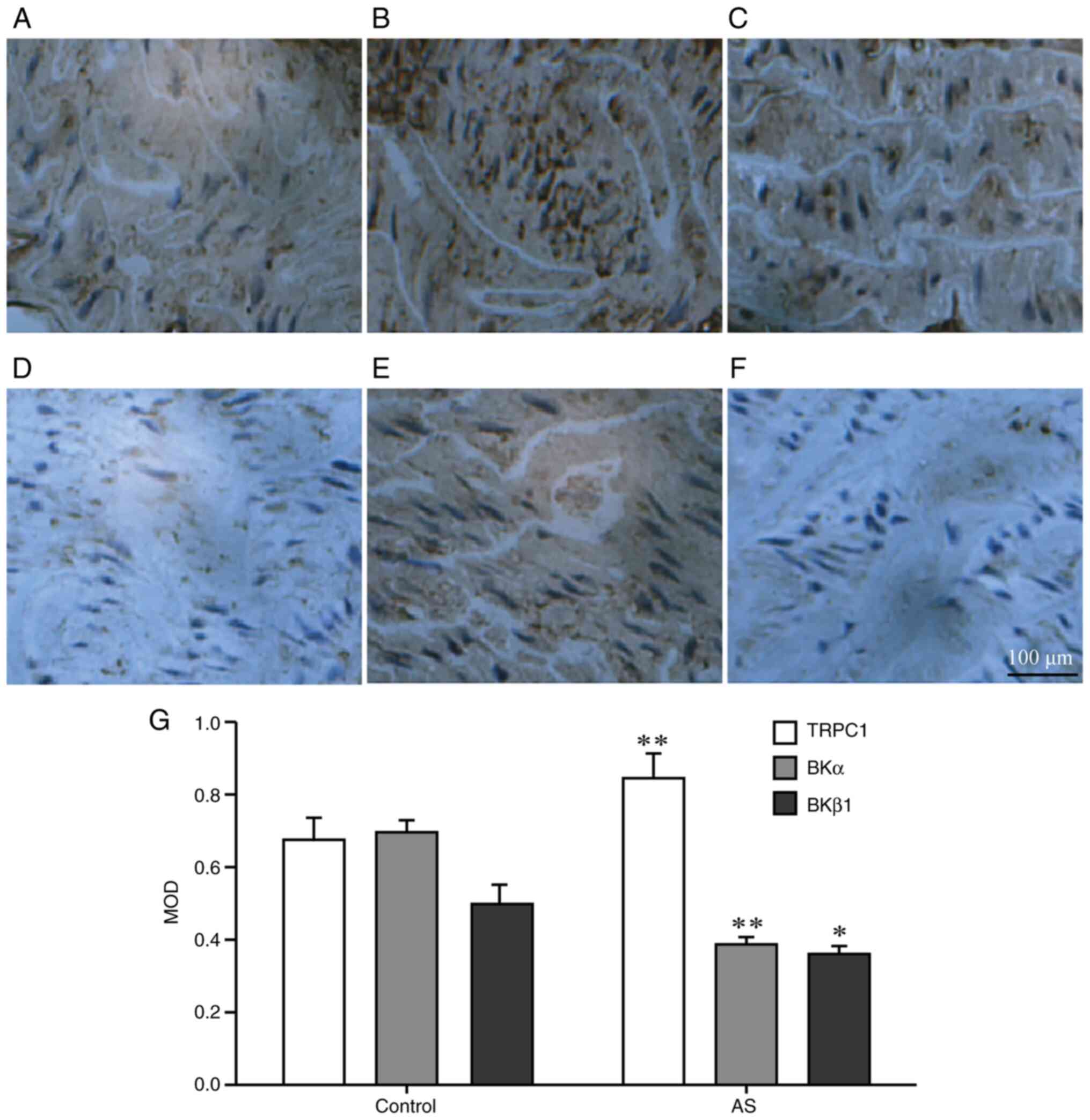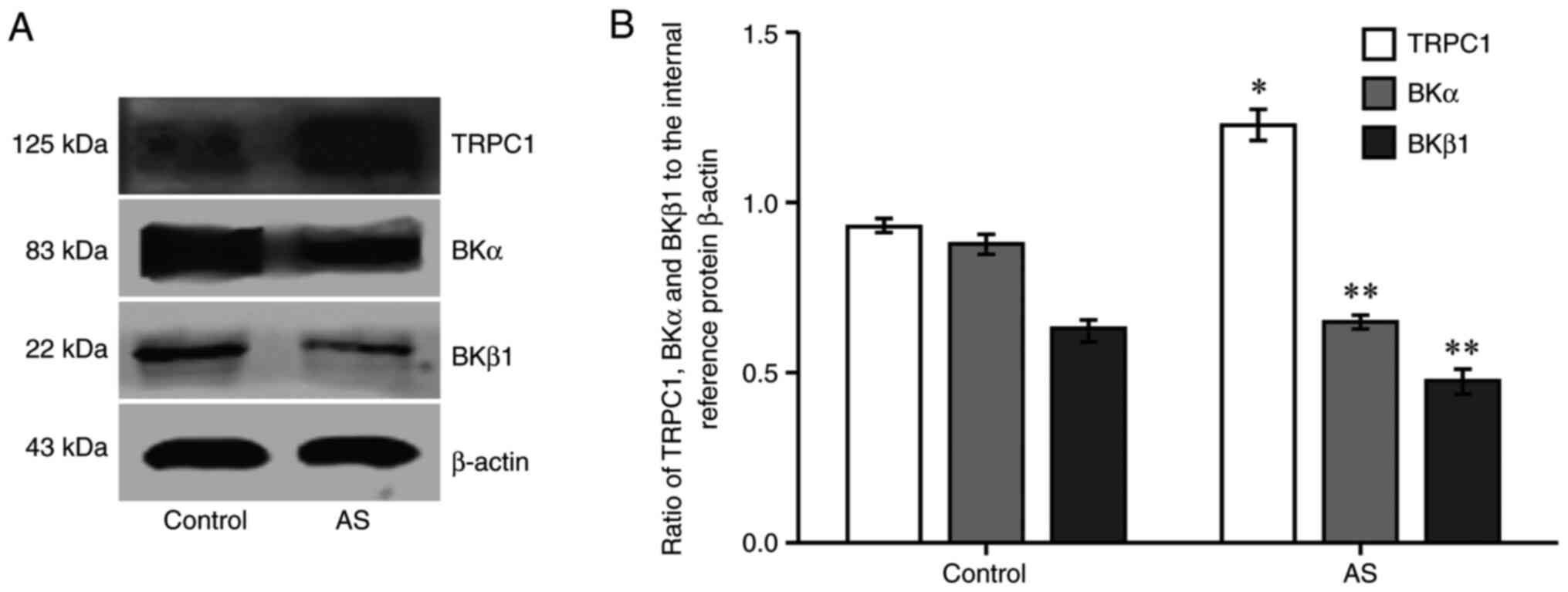|
1
|
Falk E: Pathogenesis of atherosclerosis. J
Am Coll Cardiol. 47 (Suppl 8):C7–12. 2006.PubMed/NCBI View Article : Google Scholar
|
|
2
|
Peng R, Ji H, Jin L, Lin S, Huang Y, Xu K,
Yang Q, Sun D and Wu W: Macrophage-Based Therapies for
Atherosclerosis Management. J Immunol Res.
2020(8131754)2020.PubMed/NCBI View Article : Google Scholar
|
|
3
|
Bai X, Wang WX, Fu RJ, Yue SJ, Gao H, Chen
YY and Tang YP: Therapeutic Potential of Hydroxysafflor Yellow A on
Cardio-Cerebrovascular Diseases. Front Pharmacol.
11(01265)2020.PubMed/NCBI View Article : Google Scholar
|
|
4
|
Nicholls SJ, Ballantyne CM, Barter PJ,
Chapman MJ, Erbel RM, Libby P, Raichlen JS, Uno K, Borgman M,
Wolski K, et al: Effect of two intensive statin regimens on
progression of coronary disease. N Engl J Med. 365:2078–2087.
2011.PubMed/NCBI View Article : Google Scholar
|
|
5
|
Clapham DE: TRP channels as cellular
sensors. Nature. 426:517–524. 2003.PubMed/NCBI View Article : Google Scholar
|
|
6
|
Reyes RC, Verkhratsky A and Parpura V:
TRPC1-mediated Ca2+ and Na+ signalling in
astroglia: Differential filtering of extracellular cations. Cell
Calcium. 54:120–125. 2013.PubMed/NCBI View Article : Google Scholar
|
|
7
|
Zhu Y, Ye P, Chen SL and Zhang DM:
Functional regulation of large conductance
Ca2+-activated K+ channels in vascular
diseases. Metabolism. 83:75–80. 2018.PubMed/NCBI View Article : Google Scholar
|
|
8
|
Ferguson SD, Zhou S, Xiu J, Hashimoto Y,
Sanai N, Kim L, Kesari S, de Groot J, Spetzler D and Heimberger AB:
Ependymomas overexpress chemoresistance and DNA repair-related
proteins. Oncotarget. 9:7822–7831. 2017.PubMed/NCBI View Article : Google Scholar
|
|
9
|
Liu P, Verhaar AP and Peppelenbosch MP:
Signaling Size: Ankyrin and SOCS Box-Containing ASB E3 Ligases in
Action. Trends Biochem Sci. 44:64–74. 2019.PubMed/NCBI View Article : Google Scholar
|
|
10
|
Kruglikov IL and Scherer PE: Caveolin as a
Universal Target in Dermatology. Int J Mol Sci.
21(80)2019.PubMed/NCBI View Article : Google Scholar
|
|
11
|
Son A, Kang N, Oh SY, Kim KW, Muallem S,
Yang YM and Shin DM: Homer2 and Homer3 modulate RANKL-induced
NFATc1 signaling in osteoclastogenesis and bone metabolism. J
Endocrinol. 242:241–249. 2019.PubMed/NCBI View Article : Google Scholar
|
|
12
|
Ciminski K, Pulvermüller J, Adam J and
Schwemmle M: Human MxA is a potent interspecies barrier for the
novel bat-derived influenza A-like virus H18N11. Emerg Microbes
Infect. 8:556–563. 2019.PubMed/NCBI View Article : Google Scholar
|
|
13
|
Nguyen LK, Kholodenko BN and von
Kriegsheim A: Rac1 and RhoA: Networks, loops and bistability. Small
GTPases. 9:316–321. 2018.PubMed/NCBI View Article : Google Scholar
|
|
14
|
Redondo PC, Harper AG, Salido GM, Pariente
JA, Sage SO and Rosado JA: A role for SNAP-25 but not VAMPs in
store-mediated Ca2+ entry in human platelets. J Physiol.
558:99–109. 2004.PubMed/NCBI View Article : Google Scholar
|
|
15
|
Antigny F, Konig S, Bernheim L and Frieden
M: Inositol 1,4,5 trisphosphate receptor 1 is a key player of human
myoblast differentiation. Cell Calcium. 56:513–521. 2014.PubMed/NCBI View Article : Google Scholar
|
|
16
|
Dhar M, Wayman GA, Zhu M, Lambert TJ,
Davare MA and Appleyard SM: Leptin-induced spine formation requires
TrpC channels and the CaM kinase cascade in the hippocampus. J
Neurosci. 34:10022–10033. 2014.PubMed/NCBI View Article : Google Scholar
|
|
17
|
Marom M, Birnbaumer L and Atlas D:
Membrane depolarization combined with Gq-activated
G-protein-coupled receptors induce transient receptor potential
channel 1 (TRPC1)- dependent potentiation of catecholamine release.
Neuroscience. 189:132–145. 2011.PubMed/NCBI View Article : Google Scholar
|
|
18
|
Tu CL, Chang W and Bikle DD: Phospholipase
cgamma1 is required for activation of store-operated channels in
human keratinocytes. J Invest Dermatol. 124:187–197.
2005.PubMed/NCBI View Article : Google Scholar
|
|
19
|
Singh BB, Liu X, Tang J, Zhu MX and
Ambudkar IS: Calmodulin regulates Ca(2+)-dependent feedback
inhibition of store-operated Ca(2+) influx by interaction with a
site in the C terminus of TrpC1. Mol Cell. 9:739–750.
2002.PubMed/NCBI View Article : Google Scholar
|
|
20
|
Selli C, Erac Y and Tosun M: Simultaneous
measurement of cytosolic and mitochondrial calcium levels:
Observations in TRPC1-silenced hepatocellular carcinoma cells. J
Pharmacol Toxicol Methods. 72:29–34. 2015.PubMed/NCBI View Article : Google Scholar
|
|
21
|
Dyrda A, Koenig S and Frieden M: STIM1
long and STIM1 gate differently TRPC1 during store-operated calcium
entry. Cell Calcium. 86(102134)2020.PubMed/NCBI View Article : Google Scholar
|
|
22
|
Kwan HY, Shen B, Ma X, Kwok YC, Huang Y,
Man YB, Yu S and Yao X: TRPC1 associates with BK(Ca) channel to
form a signal complex in vascular smooth muscle cells. Circ Res.
104:670–678. 2009.PubMed/NCBI View Article : Google Scholar
|
|
23
|
Kochukov MY, Balasubramanian A, Noel RC
and Marrelli SP: Role of TRPC1 and TRPC3 channels in contraction
and relaxation of mouse thoracic aorta. J Vasc Res. 50:11–20.
2013.PubMed/NCBI View Article : Google Scholar
|
|
24
|
ÁvilaMedina J: CalderónSánchez E,
GonzálezRodríguez P, Monje-Quiroga F, Rosado JA, Castellano A,
Ordóñez A and Smani T: Orai1 and TRPC1 colocalize with CaV1.2
channels to form a signal complex in vascular smooth muscle cells.
J Biol Chem. 291:21148–21159. 2016.PubMed/NCBI View Article : Google Scholar
|
|
25
|
Nascimento Da Conceicao V, Sun Y, Zboril
EK, De la Chapa JJ and Singh BB: Loss of Ca2+ entry via
Orai-TRPC1 induces ER stress, initiating immune activation in
macrophages. J Cell Sci. 133(jcs237610)2019.PubMed/NCBI View Article : Google Scholar : doi.org/10.1242/jcs.237610.
|
|
26
|
Packard RR and Libby P: Inflammation in
atherosclerosis: From vascular biology to biomarker discovery and
risk prediction. Clin Chem. 54:24–38. 2008.PubMed/NCBI View Article : Google Scholar
|
|
27
|
Andrés-Manzano MJ, Andrés V and Dorado B:
Oil Red O and Hematoxylin and Eosin Staining for Quantification of
Atherosclerosis Burden in Mouse Aorta and Aortic Root. Methods Mol
Biol. 1339:85–99. 2015.PubMed/NCBI View Article : Google Scholar
|
|
28
|
Wang LF, Gu L, Huang MX, Zhou WB, Li H and
Zhang BZ: Effects of spironolactone towards rabbit atrial
remodeling with rapid pacing. Pak J Pharm Sci. 29:151–156.
2016.PubMed/NCBI
|
|
29
|
Cochain C and Zernecke A: Macrophages and
immune cells in atherosclerosis: Recent advances and novel
concepts. Basic Res Cardiol. 110(34)2015.PubMed/NCBI View Article : Google Scholar
|
|
30
|
Davignon J, Cohn JS, Mabile L and Bernier
L: Apolipoprotein E and atherosclerosis: Insight from animal and
human studies. Clin Chim Acta. 286:115–143. 1999.PubMed/NCBI View Article : Google Scholar
|
|
31
|
Libby P, Lichtman AH and Hansson GK:
Immune effector mechanisms implicated in atherosclerosis: From mice
to humans. Immunity. 38:1092–1104. 2013.PubMed/NCBI View Article : Google Scholar
|
|
32
|
Tousoulis D, Psarros C, Demosthenous M,
Patel R, Antoniades C and Stefanadis C: Innate and adaptive
inflammation as a therapeutic target in vascular disease: The
emerging role of statins. J Am Coll Cardiol. 63:2491–2502.
2014.PubMed/NCBI View Article : Google Scholar
|
|
33
|
Tangvoraphonkchai K and Davenport A:
Magnesium and Cardiovascular Disease. Adv Chronic Kidney Dis.
25:251–260. 2018.PubMed/NCBI View Article : Google Scholar
|
|
34
|
Nesin V and Tsiokas L: TRPC1. In:
Mammalian Transient Receptor Potential (TRP) Cation Channels.
Handbook of Experimental Pharmacology. Nilius B and Flockerzi V
(eds). Vol 222. Springer, Berlin, Heidelberg, pp15-51, 2014.
|
|
35
|
Latorre R, Castillo K, Carrasquel-Ursulaez
W, Sepulveda RV, Gonzalez-Nilo F, Gonzalez C and Alvarez O:
Molecular Determinants of BK Channel Functional Diversity and
Functioning. Physiol Rev. 97:39–87. 2017.PubMed/NCBI View Article : Google Scholar
|
|
36
|
Tang X, Qian LL, Wang RX, Yao Y, Dang SP,
Wu Y, Wang W, Ji Y, Sun MQ, Xia DY, et al: Regulation of coronary
arterial large conductance Ca2+-activated K+
channel protein expression and function by n-3 polyunsaturated
fatty acids in diabetic rats. J Vasc Res. 54:329–343.
2017.PubMed/NCBI View Article : Google Scholar
|
|
37
|
Tykocki NR, Boerman EM and Jackson WF:
Smooth muscle ion channels and regulation of vascular tone in
resistance arteries and arterioles. Compr Physiol. 7:485–581.
2017.PubMed/NCBI View Article : Google Scholar
|
|
38
|
Schmidt K, Dubrovska G, Nielsen G, Fesüs
G, Uhrenholt TR, Hansen PB, Gudermann T, Dietrich A, Gollasch M, de
Wit C, et al: Amplification of EDHF-type vasodilatations in
TRPC1-deficient mice. Br J Pharmacol. 161:1722–1733.
2010.PubMed/NCBI View Article : Google Scholar
|


















